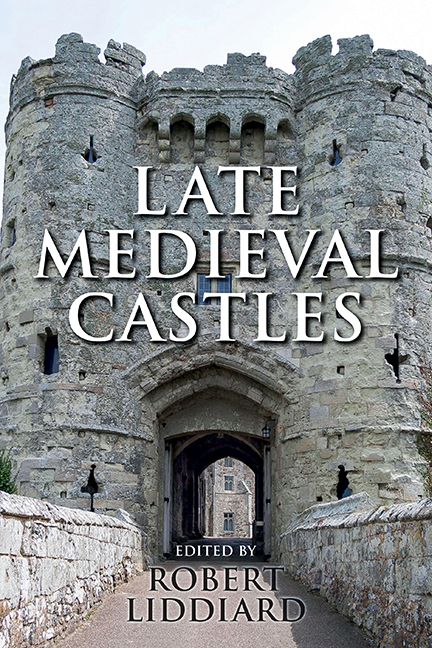Book contents
- Frontmatter
- Contents
- List of Illustrations
- Acknowledgements
- Editor's Preface
- List of Abbreviations
- A Note on the Text
- Introduction
- 1 Fourteenth-Century Castles in Context: Apotheosis or Decline?
- 2 Architects, Advisors and Design at Edward I's Castles in Wales
- 3 The Courtyard and the Tower: Contexts and Symbols in the Development of Late Medieval Great Houses
- 4 Castle Planning in the Fourteenth Century
- 5 Meaningful Constructions: Spatial and Functional Analysis of Medieval Buildings
- 6 Mota, Aula et Turris: The Manor-Houses of the Anglo-Scottish Border
- 7 Lulworth Castle, Dorset
- 8 A Scottish Problem with Castles
- 9 Structural Symbolism in Medieval Castle Architecture
- 10 Specimens of Freedom to Crenellate by Licence
- 11 Some Analysis of the Castle of Bodiam, East Sussex
- 12 English Castles in the Reign Of Edward II
- 13 Castles of Ward and the Changing Pattern of Border Conflict in Ireland
- 14 The Donjon Of Knaresborough: The Castle As Theatre
- 15 The Architecture of Arthurian Enthusiasm: Castle Symbolism in the Reigns of Edward I and his Successors
- 16 Medieval Ornamental Landscapes
- 17 Otherworld Castles in Middle English Arthurian Romance
- Guide to Further Reading
- Index
11 - Some Analysis of the Castle of Bodiam, East Sussex
Published online by Cambridge University Press: 29 April 2017
- Frontmatter
- Contents
- List of Illustrations
- Acknowledgements
- Editor's Preface
- List of Abbreviations
- A Note on the Text
- Introduction
- 1 Fourteenth-Century Castles in Context: Apotheosis or Decline?
- 2 Architects, Advisors and Design at Edward I's Castles in Wales
- 3 The Courtyard and the Tower: Contexts and Symbols in the Development of Late Medieval Great Houses
- 4 Castle Planning in the Fourteenth Century
- 5 Meaningful Constructions: Spatial and Functional Analysis of Medieval Buildings
- 6 Mota, Aula et Turris: The Manor-Houses of the Anglo-Scottish Border
- 7 Lulworth Castle, Dorset
- 8 A Scottish Problem with Castles
- 9 Structural Symbolism in Medieval Castle Architecture
- 10 Specimens of Freedom to Crenellate by Licence
- 11 Some Analysis of the Castle of Bodiam, East Sussex
- 12 English Castles in the Reign Of Edward II
- 13 Castles of Ward and the Changing Pattern of Border Conflict in Ireland
- 14 The Donjon Of Knaresborough: The Castle As Theatre
- 15 The Architecture of Arthurian Enthusiasm: Castle Symbolism in the Reigns of Edward I and his Successors
- 16 Medieval Ornamental Landscapes
- 17 Otherworld Castles in Middle English Arthurian Romance
- Guide to Further Reading
- Index
Summary
I. The Significance of Bodiam
The castle of Bodiam, blandly ensconced in its lily-pond of a moat, is well-known, but can scarcely be said to be well-understood. It represents the popular ideal of a medieval castle, and its inheritors from the Marquis Curzon of Kedleston, the National Trust, style it simply ‘the favourite castle’ in their tourist leaflet, and ‘everyone's fairy-tale castle’ in their 1985 Guide. That it has had so compelling and so enduring an impact, not least today six centuries since it was completed, triumphantly proves its success. In the modern literature of castle studies it has held a special position, which would have pleased Sir Edward Dallingridge, who sought and duly obtained licence, in October 1385, to build what has also been called ‘the most spectacular private castle of the decade’. The fairy-tale cannot be sustained and questioning analysis rather than enthusiastic advocacy is our present purpose. The equivocation of Bodiam comment, finely balanced between lurking ugly disbelief and uninhibited romantic enjoyment, to be found almost universally in all kinds and levels of work, must be resolved.
The building remains profoundly significant in a perhaps surprising variety of ways. It has been assumed to be the most notable (indeed, virtually the sole) exception to the scenario of post-Edwardian (military) ‘decline’, and it is certainly something of a test-case for the understanding of licences to crenellate. These royal patents (or charters), ostensibly authorising the construction of stone walls and battlements (and occasionally of other fortifications), usually phrased as additions to an existing dwelling, come formally into being with the commencement of enrolment under King John and last until the early Stuart period. From c.1200 until 1578 over 500 sites were licensed (some several times), nearly half of them (217) during the reign of Edward III. They have traditionally been regarded as prohibitive in purpose, reluctantly conceded, and thought to bear the imprint of a supposed royal disfavour towards noble castellation. It has also been implied that they are prescriptive, implementing some national defence plan.
- Type
- Chapter
- Information
- Late Medieval Castles , pp. 241 - 302Publisher: Boydell & BrewerPrint publication year: 2016

